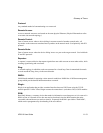Glossary of Terms
11-14
UDS-10 User Guide
Router:
Device capable of filtering/forwarding packets based upon data link layer information. Whereas a
bridge or switch may only read MAC layer addresses to filter, routers are able to read data such as IP
addresses and route accordingly.
RTEL:
Lantronix' "reverse Telnet" software allows hosts using TCP/IP to establish a session with a device
attached to a terminal server port.
Server:
A computer that provides resources to be shared on the network, such as files (file server) or terminals
(terminal server).
Session:
A connection to a network service.
Shared Ethernet:
Ethernet configuration in which a number of segments are bound together in a single collision domain.
Hubs produce this type of configuration where only one node can transmit at a time.
SLIP:
Serial Line Internet Protocol, a protocol for running TCP/IP over serial lines.
SNA:
Systems Network Architecture. IBM's layered protocols for mainframe communications.
SNMP:
Simple Network Management Protocol, allows a TCP/IP host running an SNMP application to query
other nodes for network-related statistics and error conditions. The other hosts, which provide SNMP
agents, respond to these queries and allow a single host to gather network statistics from many other
network nodes.
Source Code:
Programs in an uncompiled or unassembled form.
Spanning Tree:
An algorithm used by bridges to create a logical topology that connects all network segments, and
ensures that only one path exists between any two stations.


















